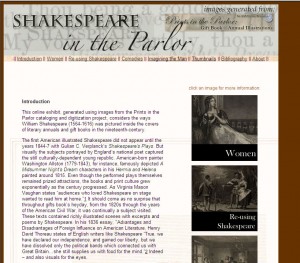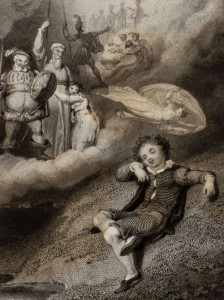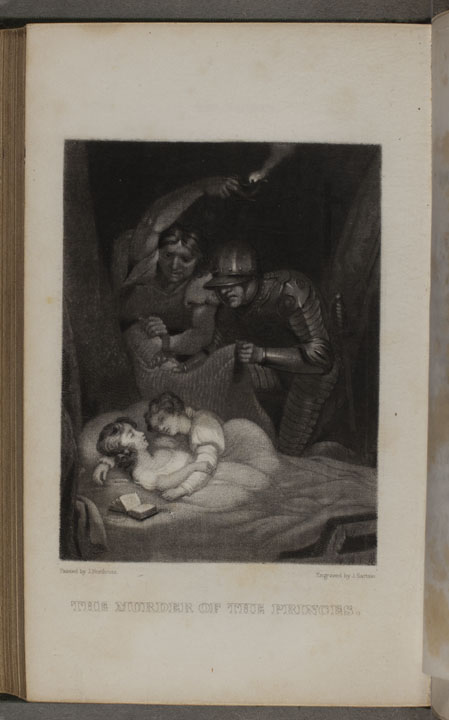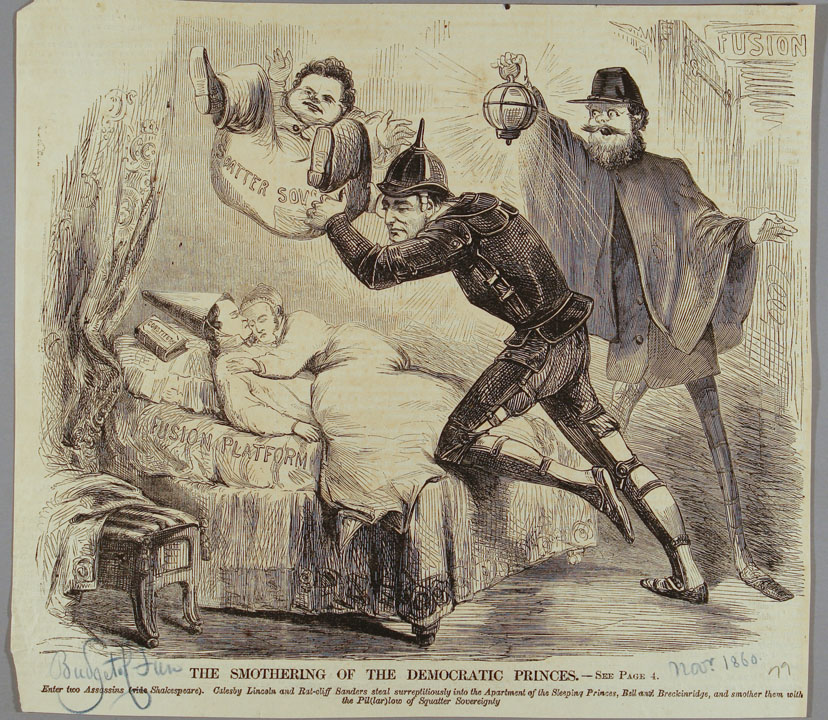As the Prints in the Parlor (PIP) Project begins its last leg of digitization and access to images generated, those of us involved with it find ourselves itching to pull together some of the results into conversation with one another. The reason for this is to show how these book illustrations, sometimes independent of the books they are contained within, can demonstrate larger contexts of print culture of the nineteenth century.
We are also hoping the web pages we are creating – with links to the catalog records and accompanying text files – will show how the resource can enable researchers to think about these prints. (Check out our online tutorial for search tips.)  One of these recent forays resulted in the mini-exhibit appropriately titled “Shakespeare in the Parlor.” It features four areas of focus – Shakespeare’s women, comedies, imagining-the-man, and re-using Shakespeare – each area with its own four representative images. Attached are also high-resolution digital photographs of the book pages, excerpts from the cataloging record, and a link to the AAS catalog entry, in addition to a short general introduction.
One of these recent forays resulted in the mini-exhibit appropriately titled “Shakespeare in the Parlor.” It features four areas of focus – Shakespeare’s women, comedies, imagining-the-man, and re-using Shakespeare – each area with its own four representative images. Attached are also high-resolution digital photographs of the book pages, excerpts from the cataloging record, and a link to the AAS catalog entry, in addition to a short general introduction.
Being exclusive was a problem in preparing the exhibit because there were so many good images from which to choose. On the chopping block, for instance, were the images of Shakespeare “places”, such as the “Palace of the Duke of Bedford” (still digitized and made available, but not included in the exhibit). Also, developing some sort of a narrative was difficult. But in essence, the prints spoke for – and almost organized – themselves. And while the place of study for Shakespeare in American study is undoubtedly the Folger Shakespeare Library in Washington, D.C., here at the AAS, we like to think we have some pieces of that Bard-pie.

With PIP, and hopefully with several mini-exhibits to follow, we have created a “bank” of images and descriptive cataloging records to work with. Our expectation is that as we make available the last few hundred images generated from the project, researchers and scholars will start to put images together in different ways and across different fields.
Doubtless, following the trail of some of these images has resulted in some fascinating leads. The “Shakespeare in the Parlor” exhibit included the print “Dreams of a Youthful Shakespeare“- after Richard Westall (1765-1836) – who worked for the John Boydell’s Shakespeare Gallery (a collection of the American prints of which are also in AAS collections).
 While “Dreams of a Youthful Shakespeare” is featured in our online exhibit, one that isn’t (but is also noteworthy) is “The Murder of the Princes” which was part of Boydell’s Shakespeare Gallery and is reproduced in PIP as well (in two separate gift books, no less). What makes this even more interesting is an image produced in Frank Leslie’s Budget of Fun in November 1860, titled “The Smothering Of The Democratic Princes” shows a new take on the already popular image but in which:
While “Dreams of a Youthful Shakespeare” is featured in our online exhibit, one that isn’t (but is also noteworthy) is “The Murder of the Princes” which was part of Boydell’s Shakespeare Gallery and is reproduced in PIP as well (in two separate gift books, no less). What makes this even more interesting is an image produced in Frank Leslie’s Budget of Fun in November 1860, titled “The Smothering Of The Democratic Princes” shows a new take on the already popular image but in which:
enter two assassins (vide Shakespeare). Catesby Lincoln and Rat-cliff Sanders steal surreptitiously into the Apartment of the Sleeping Princes, Bell and Breckinridge, and smother them with the Pil(lar)low of Squatter Sovereignty.
In this account, Shakespeare is invoked – not the subject.

“The Smothering Of The Democratic Princes” image is part of the Civil War Cartoon Collection. (Currently this collection only has an online inventory, but it is one of the Society’s holdings slated to be re-organized, re-inventoried and re-served as an online resource that will contain digital images.) It is only fitting that the subject matter was re-used as well. What this recognizes even more broadly, is that images are representatives of a sort of language so saturated in print-culture economies that it made its way back to the popular press. The staging and even subject matter could easily move from the museum, to the parlor, to the press and back again.
We have had fun organizing the images, making connections, and even finding the necessary scaffolding for our future projects. Our hope is you will do the same!
